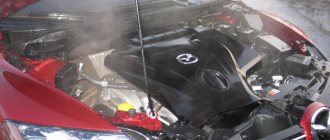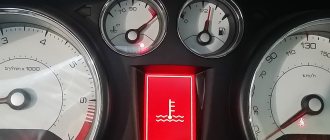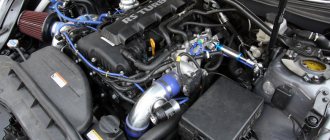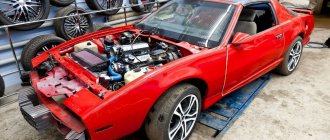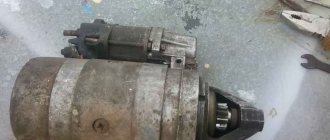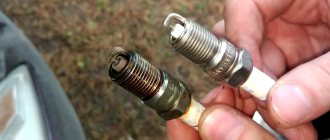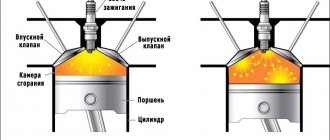Normal operation of the engine cooling system is one of the most important conditions for maximizing the service life and resource of the power unit. Also, various malfunctions of this system in some cases lead to serious consequences.
In some cases, the consequences of engine overheating are eliminated through repairs, which usually turn out to be very expensive. Another common situation is that after the motor overheats, the power plant cannot be restored and a new or contract motor is needed.
In this article we will look at the reasons for engine overheating, the consequences of overheating of a gasoline and diesel engine, and what a driver should do in such a situation.
Consequences of overheating
An experienced driver understands that protecting the engine from overheating is an excellent way to extend the life of a car and avoid serious problems. Beginners, due to lack of experience, may not know that if the temperature exceeds the calculated value, the following processes can occur:
- the surface of the pistons melts;
- oil seals are deformed;
- cylinder head gaskets are destroyed;
- “seizes” the piston in the cylinder with separation and breakage of the connecting rod;
- The cylinder head is deformed and cracks.
The extent of the problem depends on the engine overheating temperature and the duration of exposure to this unfavorable factor. The sooner the driver notices the malfunction and takes measures to eliminate it, the less damage the power unit will receive.
General information
At what temperature does the motor operate properly and how many degrees indicate a problem? Each unit has its own operating temperature values. And when it warms up well, all systems begin to function effectively - from injection control to a number of subsystems.
The operating range of almost any power plant lies in the range of 75-105 °C, which does not lead to overheating of the oil or the entire unit. However, in modern analogues this threshold is increased to 115-130 degrees.
True, this is only relevant in marketing for reporting, because in reality 120-130 °C are too high values for the piston group, as well as rubber and plastic elements. It is unlikely that overheating of the oil can be avoided here.
Signs of engine overheating
Today, vehicles are equipped with on-board computers that monitor the operating parameters of the engine. In such cars, everything is simple: the “engine overheating” error lights up on the display if its temperature exceeds the permissible limit.
Indirect signs
Sometimes the engine overheating light is silent, but the vehicle behaves strangely. It is possible that the sensor has failed or the indicator is faulty. Experienced drivers know that the warning system can fail, so you need to pay attention to indirect signs.
Even if the engine overheat sensor does not give any signals, the operating temperature may be significantly higher than optimal. The following signs often mean that the motor is overheated:
- the fan runs longer than usual;
- the operation of the “engine” is accompanied by extraneous noise;
- The interior heating does not work;
- power has dropped noticeably;
- a coating appeared on the candles;
- the coolant has darkened;
- The engine oil quickly turned black.
Ignoring such signs leads to an accident.
Chronicle of events
First, the pistons burn out, which affects the operation of the cylinders. The crankshaft gets damaged and certain elements stick to it.
In the future, the cylinder head is susceptible to impact, this can significantly affect the functioning of the engine of your vehicle.
If the pistons are strong, the crankshaft will break, the unit can continue to operate. A seized piston breaks, it causes a lot of damage to the engine, the piston pin and connecting rod damage the cylinder - your vehicle becomes unusable.
Causes of engine overheating
Most often, the engine of a “steel horse” overheats for three reasons:
- heat dissipation is impaired;
- the temperature rises where there is no cooling;
- Too much heat is generated.
Heat dissipation problems
Clogged radiator
If the radiator is covered with dirt, heat is dissipated less intensely by the air. Another possibility of a car engine overheating is deposits on the inner walls of the radiator and engine. Scale is a good heat insulator, preventing water or antifreeze from releasing thermal energy to the outside.
Faulty pump
Everything is simple here: if the pump does not pump, the coolant does not circulate, and the engine quickly overheats. It’s easy to check the pump before steam starts coming out quickly from under the hood: just check with your hands the temperature of the hoses going to the thermostat - if the pump fails, they will be barely warm.
Thermostat not working
This device maintains the temperature of the internal combustion engine in the optimal range, including, if necessary, the radiator in the coolant circuit. If the thermoelement is faulty, antifreeze or antifreeze moves only along the internal circuit and does not enter the radiator.
The device is checked like this: you need to warm up the car, and then check the pipes going to the radiator and thermostat. If they are approximately the same temperature, everything is normal. If the tube going to the radiator is noticeably colder, it means the device is not working.
Overheating due to lack or quality of engine oil
If there is not enough engine oil (below the minimum mark), or the oil does not meet the tolerances, or it turns out to be a fake, then overheating is possible under medium and high long-term loads.
Synthetic motor oil "Suprotec Atomium" 5W-40 4l
Synthetic motor oil with viscosity grade 5W-40. Buy oil with a manufacturer's warranty.
more reviews
However, even with good oil, engine overheating is also possible if operating conditions are too extreme over long periods. For example, in motorsports, which is why athletes are forced to use an additional heat exchanger to cool the oil.
The problem of temperature rise in uncooled elements
Faulty radiator cooling fan
For forced cooling of the radiator device, an electrically driven fan is used. The device turns on when the coolant heats up above a preset level. If the device fails, overheating of the car engine at idle or in a traffic jam is inevitable.
Lack of coolant
If there is not enough antifreeze or antifreeze, heat is dissipated worse. When this malfunction occurs, the interior heating is the first to stop functioning. Air pockets collect at the highest point of the system - the radiator, from which the air inside the car is heated.
Problem with generating excessive heat
Faulty temperature sensor
This cause of engine overheating is perhaps the most insidious, because it acts quietly and imperceptibly. Like a saboteur. Outwardly, it seems that the engine is normal - there are no signals, because either the sensor does not transmit information about the malfunction, or the indicator does not send a signal to the driver.
You can understand that the engine overheating sensor has “died” by the accompanying symptoms. This is quite difficult for inexperienced drivers. Advice: monitor the behavior of your car. Suspect a problem? Run to a car service center.
Local engine overheating
It happens that the cause of engine overheating is improper ignition of the air-fuel mixture. This is possible if the ignition system “slows down” or the gas distribution mechanism or valves “stupid”.
Faulty ignition system
If the ignition is delayed, the mixture of fuel vapor and air burns out later than intended by the engine designers. The exhaust valve is already open, but the air-fuel mixture is still burning. The temperature of the exhaust gases increases. The cylinder head quickly overheats, since its cooling “jacket” is not designed for such heating.
Failures in the timing belt
Although the reason is somewhat different, the consequences are similar - engine overheating where the designers did not expect. In this case, the air-fuel mixture burns on time, but the exhaust valve opens earlier than necessary. The result is logical: cylinder head overheating.
Valve problems
Sometimes local overheating of the engine of a VAZ or other car is possible even if the ignition and timing belt are in order. For example, if the valves or seats are covered with carbon deposits. With such a malfunction, the air-fuel mixture breaks into the air supply or exhaust channels. The flame heats the pipes, and from them the entire “engine” overheats.
Overheating under prolonged loads
Among the reasons for engine overheating, improper operation of the car is not the least important. Long-term transportation of another vehicle or a loaded trailer causes the engine to overheat.
Stop the car immediately if the engine overheating light is on! You shouldn't hope that things will work out somehow. Temperature violation for even 20 minutes. will lead to a major malfunction.
Driver skill
Now a few words about the mentioned gasket. Learn to feel the car, treat it like a living being. Would you like to work constantly under critical loads? Do not force the engine by pressing the pedal to the floor, especially at low speeds. Try to avoid situations with prolonged slipping and sudden accelerations that make no sense. Believe me, the machine will reward you with reliability and proper operation in any situation.
Another point typical for summer trips to the country. Don’t try to take everything away at once; a passenger car is not designed for that. If you want to get into cargo transportation, buy a Gazelle. True, no one can guarantee that it won’t boil either; there is such a constructive predisposition.
The main problem is that the car is simply not capable of driving with overload at high speeds. As a result, we get the engine operating in critical modes, after all, it’s hard for him, he was not ready for such tests. The oncoming air flow is insufficient to effectively cool the radiator. And if all this is also accompanied by other problems in the cooling system, which are to some extent characteristic of any car, then all the prerequisites for overheating become obvious.
In general, treat your car with understanding and listen to its behavior. This will allow you to significantly save on repairs.
What to do
First of all, after the engine overheats, you need to find the cause. Then take appropriate measures:
- replace a faulty device (pump, temperature sensor, thermostat or fan),
- adjust the timing belt or ignition,
- clean the radiator and cooling system,
- add coolant to the reservoir,
- add or change engine oil,
- clean the valves from carbon deposits.
Replacing faulty devices, adjusting the timing belt and ignition should be entrusted to professionals; cleaning the radiator from the inside, if you have the skills, can be done with your own hands. Adding coolant and oil is not difficult for any driver.
You can clean the valves yourself, and it is not necessary to disassemble the motor. If the case is not completely advanced, the use of special tribotechnical compounds gives a good result.
For example, flushing the Suprotek fuel system has proven itself to be excellent. This product is added to the fuel once. There are two types of products: for gasoline and diesel fuel. The composition completely dissolves in fuel, improving its cleaning properties.
Suprotec cleaner removes deposits from valves and seats, as well as other fuel system components. As a result, the operation of these nodes is optimized. The cause of overheating is eliminated, and the motor begins to operate at the designed temperature. The power of the internal combustion engine increases, as the compression ratio of the air-fuel mixture is restored to standard values.
Gasoline fuel system cleaner "Suprotek"
Additive for cleaning all elements of the gasoline fuel system. Injector and valve cleaner.
more reviews
Use of low-quality fuel
This reason can be encountered much less often today than in the old days, thanks to fuel quality control at gas stations. But a similar situation, especially in the periphery, still occurs.
Unstable engine operation, impossibility of complete combustion of fuel, drop in power and correspondingly increased load, detonation processes. All this entails a significant increase in the temperature of the block. At the slightest predisposition (disturbances in the cooling system), overheating occurs, and it can reach critical proportions.
The main signs that you are in serious trouble at a gas station:
- Unstable engine operation. It jerks, jerks, and tries to stall, especially at idle.
- The color of the exhaust gases has changed. In some cases, you get the feeling that you don’t have an ordinary passenger car, but a fully loaded diesel long vehicle.
- The car started to feel sluggish, doesn’t want to gain momentum, and you can completely forget about sharp acceleration.
By the way, in such situations, pay attention to the fuel filter. A significant volume of separated water and mechanical impurities that literally clogged the device just a few kilometers after refueling. All this indicates the low quality of the filled fuel.
In such a situation, do not take risks, replace the fuel, it will be much cheaper to refill the tank with a new one, repairs will cost much more.
Preventing engine overheating
It is easier to prevent the problem than to correct it, malfunctions after the car engine overheats. Therefore, it is better to take care in advance to protect the friction surfaces from failure even when overheated; treat the internal combustion engine using the SUPROTEC technology using tribotechnical compounds “Active PLUS” or “Active STANDARD”. In addition, it is necessary to ensure that the radiator is clean, the pump, fan and thermostat are in order, and there is enough coolant.
Engine additive "Suprotek Active Standard"
For naturally aspirated petrol engines up to 1.6 litres. Restores and equalizes compression, reduces fuel and oil consumption due to waste, protects friction surfaces in the CPG and gas distribution mechanism from wear during startup and overheating.
more reviews
Engine oil additive "Suprotek Active Plus"
Restores compression, reduces fuel consumption and oil waste, reduces wear rate and extends the life of internal combustion engines of any type. Facilitates cold starts and protects against overheating in traffic jams.
more reviews
Monitor the condition of the power unit. Try to refuel at reputable gas stations where gasoline or diesel fuel is of adequate quality to keep your engine in good condition. To prevent deposits on seats and valves, regularly use the additive “Suprotek Aprokhim SGA” or its analogues.
Incorrect adjustment of ignition and gas distribution systems
Yes, and these systems make their negative contribution to increasing temperatures to critical limits. Therefore, trust the adjustment only to professional mechanics who know the machine and its features like the back of their hand.
Most often, problems arise due to the incorrect timing setting. Combustion of fuel at inappropriate times leads to the removal of exhaust gases while still at a high temperature. As a result, we get a picture that is in many ways similar to the situation with burnt out valves.
Incorrect adjustment of the gas distribution mechanism also produces a similar effect. If the chain jumps 1 tooth, nothing critical will happen, although this situation is also undesirable. And if the displacement is greater, then the entire system will operate in a non-standard mode. This leads not only to overheating, but also to a decrease in engine power. Faults of this kind can only be identified through detailed diagnostics.
Feeding a mixture that is too lean or too rich has a similar effect. These deviations can be determined by simply examining the spark plugs. Dry white spark plugs indicate a lack of fuel, while flooded spark plugs indicate an excess of fuel.
Change of oil
Another equally interesting question is why and is it necessary to change the lubricant at all after the internal combustion engine has become very hot? It’s worth delving a little deeper into the essence - an important characteristic of any consumable lubricant for a power plant is its viscosity. But if the permissible temperature threshold is exceeded, motor lubricant loses its qualities.
Viscosity within normal limits covers the rubbing parts with a thin film, thereby preventing close metal-to-metal contact. Due to overheating of the oil, its consumption increases significantly, and serious damage is caused to metal surfaces due to friction.
In addition, the additives present in the product are destroyed and as a result, gases, acids, and a number of other harmful compounds are formed that do not dissolve. Circulating inside the internal combustion engine, they inevitably cause damage of varying severity. Thus, the answer to the question: is it necessary to change the oil after it is very hot - yes.
Any suspicions? Let's check!
While it is easy to check the condition of the radiator or the fluid level in the expansion tank, the average driver will not be able to find out anything about the thermostat, water pump, or the quality of antifreeze. Antifreeze usually lasts 5 years; the pump, depending on the model, is changed every 60,000 - 100,000 km. More exact dates can be found at the nearest FAVORIT MOTORS Group dealership: if you suspect that the engine is overheating, sign up for diagnostics right now. Remember that real overheating is always a big expense, which is actually easy to avoid.
Source
Protective measures
Anyone who understands electricity knows perfectly well that any single-phase motor needs good protection against overload and extreme heat. The same applies to a car engine. How to prevent overheating? To do this, you should adhere to a number of preventive measures:
- Strictly follow all the manufacturer’s recommendations, for which it is enough to study the vehicle’s registration certificate.
- Monitor the coolant and oil levels in the engine.
- Avoid aggressive driving style.
- Carry out regular maintenance.
- Use the services of professional diagnostics, as this will allow you to avoid mistakes and detect a malfunction in time.
Following these simple recommendations will protect the engine from temperature overloads.
